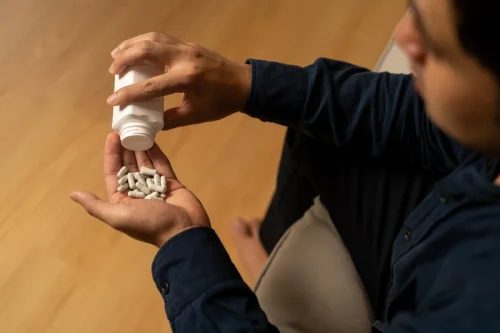Expanding the continuum of substance use disorder treatment: Nonabstinence approaches PMC

About 10% of individuals who report cannabis use in the past year meet criteria for a cannabis use disorder, while this proportion increases to 18%, 19%, 58%, and 65% of those with past year use of cocaine, opioids (misuse), methamphetamine, and heroin, respectively. These data suggest that non-disordered drug use is possible, even for a substantial portion of individuals who use drugs such as heroin (about 45%). However, they do not elucidate patterns of https://ecosoberhouse.com/ non-disordered use over time, nor the likelihood of maintaining drug use without developing a DUD. It is essential to understand what individuals with SUD are rejecting when they say they do not need treatment. In this model, treatment success is defined as achieving and sustaining total abstinence from alcohol and drugs, and readiness for treatment is conflated with commitment to abstinence (e.g., Harrell, Trenz, Scherer, Martins, & Latimer, 2013).
Current Study

People who battle addiction can hurt themselves, hurt others, damage their health, make irresponsible choices and even risk prison time or death. If you have a history of problems where alcohol is the root cause, it’s not the time to play around with new forms of treatment. Professional programs of therapy and abstinence have been successful for thousands of people to reclaim control of their lives and move on from addiction. Parameters were estimated using a weighted maximum likelihood function, and all standard errors were computed using a sandwich estimator (i.e., MLR in Mplus; B. O. Muthén & Satorra, 1995). The robust maximum likelihood estimator provides the estimated variance-covariance matrix for the available outcome data and, therefore, all available drinking data during treatment were included in the models.
Study Inclusion Criteria
Nearly one-third of individuals in the United States meet lifetime criteria for an alcohol use disorder (AUD)(Grant et al., 2015). Fortunately, most individuals who develop an AUD will eventually resolve their problem, with “recovery” defined in various ways across studies (Dawson et al., 2005; Tucker et al., 2006, 2009; Witkiewitz et al., 2019). Having scientifically sound definitions of recovery from AUD that can be shared across population and individual levels of analysis is fundamental to recovery research. Alcoholics Anonymous (AA; 1939) advanced the seminal definition of recovery as a spiritual journey to overcome the effects of uncontrollable alcohol use and to rebuild one’s inner and outer life, a lifelong journey for which abstinence was necessary, but not sufficient to effect this life-altering transformation.
3 Stepwise regressions: Non-abstinence
Such findings would aid in refining AUD treatment and would provide more information for clinicians to improve clinical decision-making. They are two alternative psychotherapies on the primary care list of priorities to help persist in abstinence. However, at present, a comparison of rehabilitation strategies through MET for patients in different periods of AUDs remains to be explored. This study also shows some psychotherapies with significant efficacy but low or very low quality, requiring further research and investment.

They found that their controlled drinking intervention produced significantly better outcomes compared to usual treatment, and that about a quarter of the individuals in this condition maintained controlled drinking for one year post treatment (Sobell & Sobell, 1973). Rychtarik et al. found that treatment aimed at abstinence or controlled drinking was not related to patients’ ultimate remission type. Booth, Dale, and Ansari (1984), on the other hand, found that patients did achieve their selected goal of abstinence or controlled drinking more often.
The descriptions on how the tools from treatment were initially used to deal with SUD and were later used to deal with other problems in the lives of IPs can be put in relation to the differentiation between abstinence and sobriety suggested by Helm (2019). While abstinence refers to behaviour, sobriety goes deeper and concerns the roots of the problem (addiction) and thereby refers to mental and emotional aspects. Differentiating these concepts opens up for recovery without necessarily having strong ties with the recovery community and having a life that is not (only) focused on recovery but on life itself. Also, defining sobriety as a further/deeper step in the recovery process offers a potential for 12-step participants to focus on new goals and getting involved in new groups, not primarily bound by recovery goals. Further, describing recovery as a process also implies paying attention to contributing factors outside the treatment context, such as the importance of work, family and friends.
- More evidence from high quality randomised controlled trials is needed, as are strategies using combined interventions (combinations of drug interventions or drug and psychosocial interventions) to improve treatment of alcohol dependency in primary care.
- Potential correlates of non-abstinent recovery, such as demographics andtreatment history, were based on NESARC results.
- In addition, the compliance of the active interventions also did not show better evidence than TAU in Figure 3 (12 articles included).
- While there have been calls for abstinence-focused treatment settings to relax punitive policies around substance use during treatment (Marlatt et al., 2001; White et al., 2005), there may also be specific benefits provided by nonabstinence treatment in retaining individuals who continue to use (or return to use) during treatment.
Regarding the limitations, the completion and conviction of the conclusion may be weakened by the following aspects. First, some therapies included had few clinical studies and insufficient sample sizes for pooling or looping analyses.43 Second, the small number of included studies and the lack of severity stratification of results in some of the studies did not facilitate the exploration of the association between severity and outcomes. Third, there was a lack of rigorous reports on randomization methods, allocation concealment, and control of implementation bias. Fourth, due to the influence of complex clinical factors and the limitations of the report content, the parameters of psychological intervention are indeed insufficient to support the impact on the outcomes by the duration, which needs to be further explored in clinical practice in the future. Furthermore, this article did not include multiple follow-up time points for analyses due to the limited outcome designs of the eligible studies. Three main continuous variables were analyzed, in which PDA used the weighted mean difference (WMD) as the effect size (ES); Cohen’s d method28 was used to eliminate the influence of nonuniform dimensions of DDD and craving change.
- The Swedish treatment system has been dominated by total abstinence as the goal, although treatment with CD as a goal exists (e.g., Agerberg, 2014; Berglund et al., 2019).
- For the network of PDA, motivational enhancement treatment (MET) (35.44, 11.78 to 59.09, high-certainty) and couple therapy (CT) (28.89, 13.42 to 44.36, moderate-certainty) were significantly different from treatment as usual (TAU) with the surface under the cumulative ranking curve (SUCRA) mean rank 1.9 and 1.9 respectively.
- In the present article, clients treated in 12-step programmes were reinterviewed five years after treatment.
- Simply put, MM is a moderate drinking program that provides a solution other than complete abstinence.
- These data were collected as part of a multisite clinical trial of alcoholism treatments supported by a series of grants from the National Institute on Alcohol Abuse and Alcoholism and made available to the authors by the Project MATCH Research Group.
We found that outcomes were reported over a wide range of time points between three and 24 months. We categorised outcomes (in a slight change from the protocol10) into short (3-6 months), medium (6-12 months), and long (12-24 months) term outcomes. If a trial reported results at multiple time points, we extracted the result at the longest time point within these periods for the main analysis. To enable all studies to be included, in the main analysis we combined results reported at the nearest time point to 12 months from each study. A second reviewer (RGE, LAM, SD, AT, or GJM) also independently screened the titles and abstracts identified from the primary source of randomised controlled trials (CENTRAL), comprising more than half of the search results. The main screener missed none of the studies eventually included in the review, indicating a low likelihood that trials were missed in the other sources.

Depending on the number of criteria met, an individual will be diagnosed with mild, moderate, or severe AUD.Individuals with severe AUD often find that in the long term, sobriety is the most achievable goal for them. Keeping alcohol in your life in a healthy way can be really challenging, especially for people who have exhibited more severe drinking habits and patterns. In terms of the strengths of this review, first, to ensure the designs of evidence-based evidence sources are rigorous and alcohol abstinence vs moderation similar enough, this study only included relevant RCTs, focused on the dependent component in AUD, and excluded transient heavy drinking, and hazardous drinking implying risk prediction. Second, this study conducted GRADE evaluations for direct, indirect, and network meta-analyses, which have not been done previously. It is well known to both clinicians and researchers in the addiction field that patients in alcoholism treatment vary dramatically with respect to their alcohol use goals.



Commenti recenti